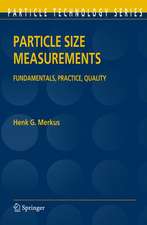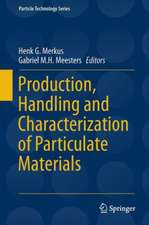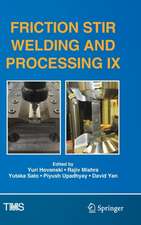Particulate Products: Tailoring Properties for Optimal Performance: Particle Technology Series, cartea 19
Editat de Henk G. Merkus, Gabriel M.H. Meestersen Limba Engleză Hardback – 2 dec 2013
- dense particle packing in relation to sufficient strength is required in concrete construction, ceramic objects and pharmaceutical tablets
- good sensorial properties (mouthfeel) to chocolate and ice cream
- effective dissolution, flow and compression properties for pharmaceutical powders
- adequate hiding power and effective coloring of paints for protection and the desired esthetical appeal of the objects
- adequate protection of our body against sun light by sunscreen
- effective particle transport and deposition to desired locations for medical inhalers and powder paints.
Adequate particle size distribution, shape and porosity of particulate products have to be achieved in order to reach optimum product performance. This requires adequate management of design and development as well as sufficient knowledge of the underlying principles of physics and chemistry. Moreover, flammability, explosivity and other health hazards from powders, during handling, are taken into account. This is necessary, since great risks may be involved. In all aspects, the most relevant parameters of the size distribution (and particle shape) have to be selected.
In this book, experts in the different product fields have contributed to the product chapters. This provides optimum information on what particulate aspects are most relevant for behavior and performance within specified industrial products and how optimum results can be obtained. It differs from other books in the way that the critical aspects of different products are reported, so that similarities and differences can be identified. We trust that this approach will lead to improved optimization in design, development and quality of many particulate products.
| Toate formatele și edițiile | Preț | Express |
|---|---|---|
| Paperback (1) | 649.71 lei 6-8 săpt. | |
| Springer International Publishing – 23 aug 2016 | 649.71 lei 6-8 săpt. | |
| Hardback (1) | 663.79 lei 6-8 săpt. | |
| Springer International Publishing – 2 dec 2013 | 663.79 lei 6-8 săpt. |
Din seria Particle Technology Series
- 18%
 Preț: 735.53 lei
Preț: 735.53 lei - 15%
 Preț: 669.66 lei
Preț: 669.66 lei -
 Preț: 383.50 lei
Preț: 383.50 lei - 18%
 Preț: 1545.88 lei
Preț: 1545.88 lei - 15%
 Preț: 642.51 lei
Preț: 642.51 lei - 18%
 Preț: 998.97 lei
Preț: 998.97 lei - 18%
 Preț: 1386.48 lei
Preț: 1386.48 lei - 18%
 Preț: 947.50 lei
Preț: 947.50 lei - 18%
 Preț: 1386.92 lei
Preț: 1386.92 lei - 18%
 Preț: 1389.62 lei
Preț: 1389.62 lei - 18%
 Preț: 1556.28 lei
Preț: 1556.28 lei - 15%
 Preț: 641.71 lei
Preț: 641.71 lei - 18%
 Preț: 942.94 lei
Preț: 942.94 lei - 18%
 Preț: 953.82 lei
Preț: 953.82 lei - 24%
 Preț: 793.38 lei
Preț: 793.38 lei - 18%
 Preț: 1114.02 lei
Preț: 1114.02 lei - 18%
 Preț: 888.80 lei
Preț: 888.80 lei - 18%
 Preț: 1224.68 lei
Preț: 1224.68 lei - 18%
 Preț: 1823.07 lei
Preț: 1823.07 lei - 18%
 Preț: 1226.60 lei
Preț: 1226.60 lei - 18%
 Preț: 2094.10 lei
Preț: 2094.10 lei - 18%
 Preț: 1234.46 lei
Preț: 1234.46 lei - 18%
 Preț: 1394.52 lei
Preț: 1394.52 lei - 18%
 Preț: 1226.24 lei
Preț: 1226.24 lei
Preț: 663.79 lei
Preț vechi: 780.93 lei
-15% Nou
Puncte Express: 996
Preț estimativ în valută:
127.03€ • 137.94$ • 106.71£
127.03€ • 137.94$ • 106.71£
Carte tipărită la comandă
Livrare economică 22 aprilie-06 mai
Preluare comenzi: 021 569.72.76
Specificații
ISBN-13: 9783319007137
ISBN-10: 3319007130
Pagini: 488
Ilustrații: XVIII, 469 p. 151 illus., 72 illus. in color.
Dimensiuni: 155 x 235 x 32 mm
Greutate: 1.07 kg
Ediția:2014
Editura: Springer International Publishing
Colecția Springer
Seria Particle Technology Series
Locul publicării:Cham, Switzerland
ISBN-10: 3319007130
Pagini: 488
Ilustrații: XVIII, 469 p. 151 illus., 72 illus. in color.
Dimensiuni: 155 x 235 x 32 mm
Greutate: 1.07 kg
Ediția:2014
Editura: Springer International Publishing
Colecția Springer
Seria Particle Technology Series
Locul publicării:Cham, Switzerland
Public țintă
ResearchCuprins
Preface.- 1 Introduction by Henk G. Merkus and Gabriel M.H. Meesters.- 2 Basic Information for Design of Particulate Products by G. Henk Merkus.- 3 Measurement of Particle Size, Shape, Porosity and Zeta-potential by Henk G. Merkus.- 4 Assessment and Control of Fire and Explosion Hazards and Risks of Particulates by Saul M. Lemkowitz and Hans J. Pasman.- 5 Particle and Fiber Toxicology by Georgia K. Hinkley and Stephen M. Roberts.- 6 Ceramics - Effect of Powder and Slurry Properties on Quality by Makio Naito.- 7 Chocolate.- 8 Propellants.- 9 Dry powder inhalers.- 10 Powder coatings.- 11 The role of particle size in drug release and absorption.- 12 Pharma powders.- 13 Powder coatings and the effects of particle size.- 14 An Overview of Physical (Particulate) Sunscreen by David Fairhurst.- 15 Increased Antimicrobial Cctivity of Cheese Coatings through Particle Size Reduction by Gabriel M.H. Meesters and Stephen L.A. Hennart.
Notă biografică
Dr Henk G. Merkus has been working at Delft University of Technology for about 35 years, the last 20 years of it in Particle Characterization in the Particle Technology Group of prof. Brian Scarlett. Also, for about 15 years he has been a member of ISO/TC24 on Sieving and Other Methods for Particle Size Measurement and he still is. Retired now the author is active in giving courses on this subject, in the Netherlands as well as in Sweden and the United Kingdom.
Dr Merkus is the author of the Springer book “Particle Size Measurements” (2009).
Dr Ir Gabriel M.H. Meesters is affiliated to DSM Food Specialities and Delft University of Technology Delft. He has 10 patents filed and 5 issued, and will be one of the organizers of the technical program of PARTEC 2013 in Nuremberg, Germany.
Dr Merkus is the author of the Springer book “Particle Size Measurements” (2009).
Dr Ir Gabriel M.H. Meesters is affiliated to DSM Food Specialities and Delft University of Technology Delft. He has 10 patents filed and 5 issued, and will be one of the organizers of the technical program of PARTEC 2013 in Nuremberg, Germany.
Textul de pe ultima copertă
Particulate products make up around eighty percent of chemical products, from all industry sectors. Examples given in this book include construction materials, fine ceramics and concrete, chocolate and ice cream, pharmaceutical, powders, medical inhalers and sun screen, liquid and powder paints.
Size distribution and the shape of the particles provide for different functionalities in these products, some general some specific. This book addresses particle packing as well as its relation to powder flow and rheological behavior. Moreover, general relationships to particle size are discussed for e.g. color and sensorial aspects of particulate products.
The book covers all the particulate aspects that are most relevant for behavior and performance within specified industrial products and how optimal results can be obtained. It differs from other books in the way that the critical aspects of different products are reported, so that similarities and differences can be identified. Contributors to this book are acknowledged experts coming from a wide range of different product industries.
The aim of the book is to lead to improved optimization in design, development and quality of many particulate products.
Size distribution and the shape of the particles provide for different functionalities in these products, some general some specific. This book addresses particle packing as well as its relation to powder flow and rheological behavior. Moreover, general relationships to particle size are discussed for e.g. color and sensorial aspects of particulate products.
The book covers all the particulate aspects that are most relevant for behavior and performance within specified industrial products and how optimal results can be obtained. It differs from other books in the way that the critical aspects of different products are reported, so that similarities and differences can be identified. Contributors to this book are acknowledged experts coming from a wide range of different product industries.
The aim of the book is to lead to improved optimization in design, development and quality of many particulate products.
Caracteristici
Covers particle materials of topical import in many industries Links specific particle characteristics to the critical performance factors relevant to industrial applications Edited by experts acknowledged in both academia and industry




















